Assessing the Relationship Between Physical Activity and the Gut Microbiome in a Large, Population-Based Sample of Wisconsin Adults

Abstract
The gut microbiome is an important factor in human health and disease. While preliminary studies have found some evidence that physical activity is associated with gut microbiome richness, diversity, and composition, this relationship is not fully understood and has not been previously characterized in a large, population-based cohort. In this study, we estimated the association between several measures of physical activity and the gut microbiota in a cohort of 720 Wisconsin residents. Our sample had a mean age of 55 years (range: 18, 94), was 42% male, and 83% of participants self-identified as White. Gut microbial composition was assessed using gene sequencing of the V3-V4 region of the 16S rRNA extracted from stool. We found that an increase of one standard deviation in weekly minutes spent in active transportation was associated with an increase in alpha diversity, particularly in Chao1’s richness (7.57, 95% CI: 2.55, 12.59) and Shannon’s diversity (0.04, 95% CI: 0.0008, 0.09). We identified interactions in the association between Inverse Simpson’s diversity and physical activity, wherein active transportation for individuals living in a rural environment was associated with additional increases in diversity (4.69, 95% CI: 1.64, 7.73). We also conducted several permutational ANOVAs (PERMANOVA) and negative binomial regression analyses to estimate the relationship between physical activity and microbiome composition. We found that being physically active and increased physical activity time were associated with increased abundance of bacteria in the family Erysipelotrichaceae. Active transportation was associated with increased abundance of bacteria in the genus Phascolarctobacterium, and decreased abundance of Clostridium. Minutes in active transportation was associated with a decreased abundance of the family Clostridiaceae.